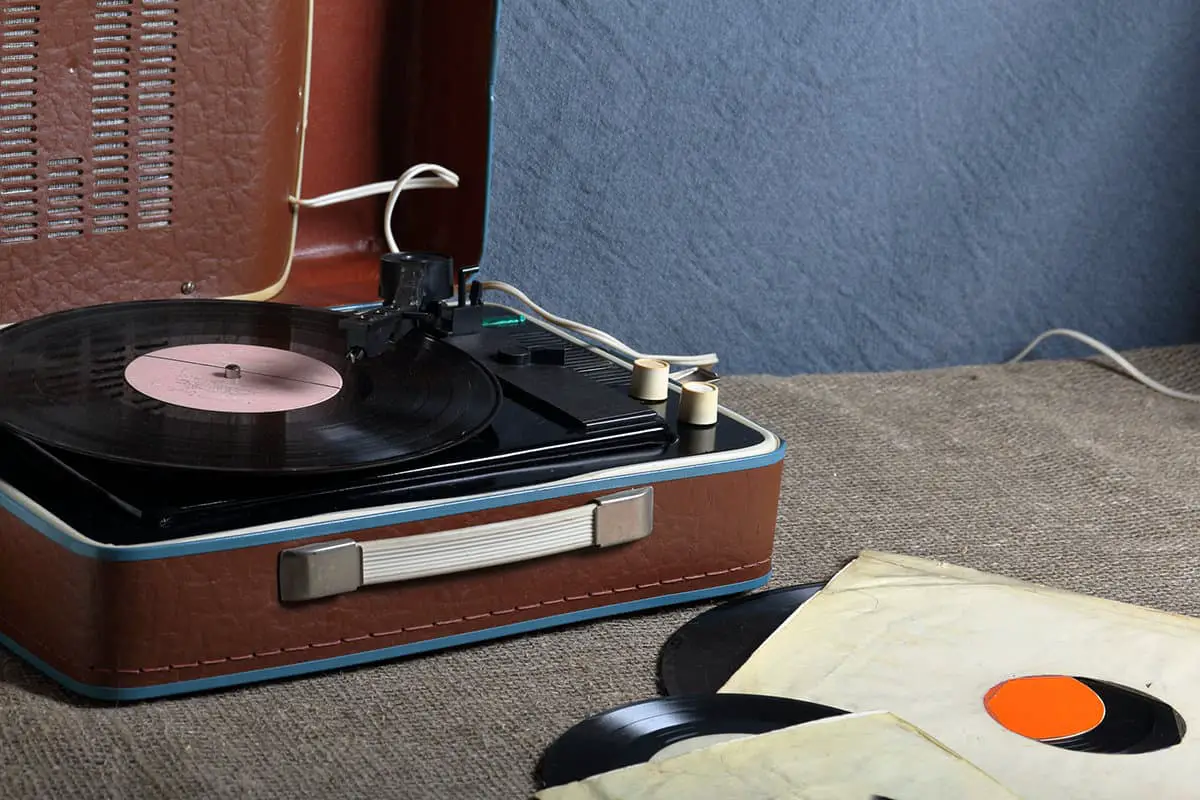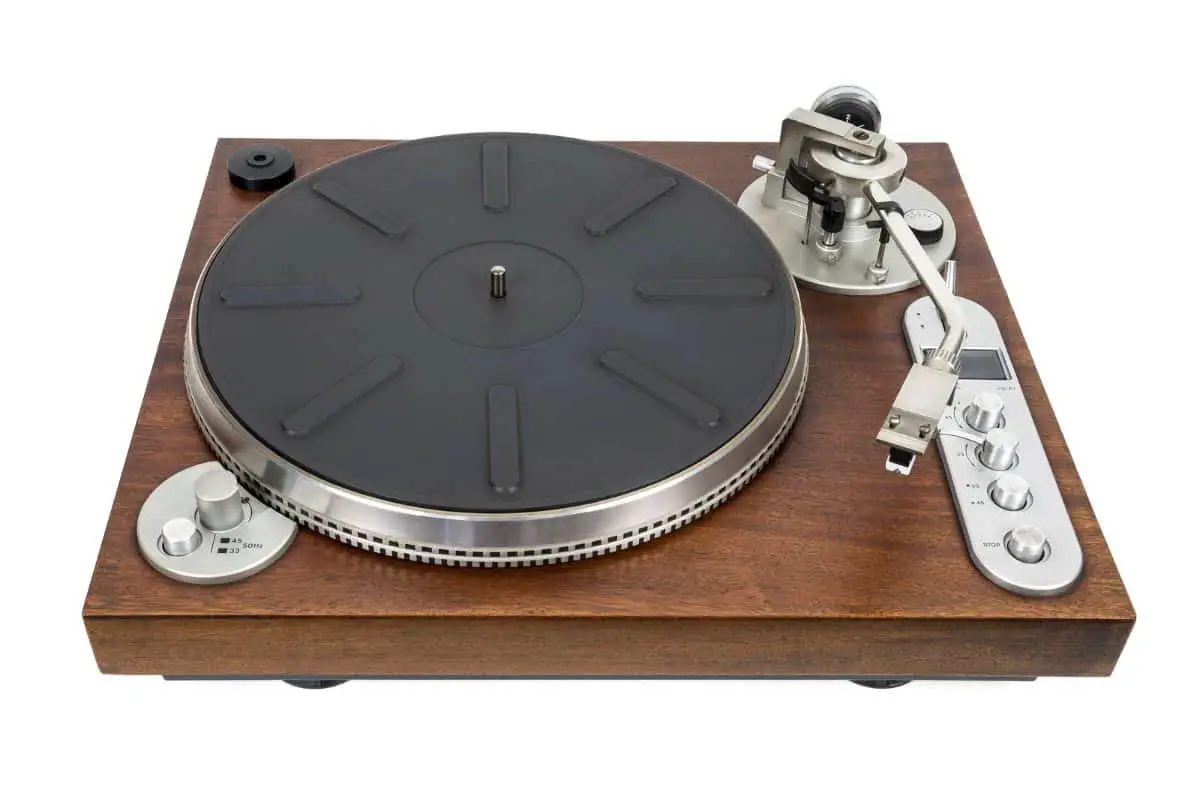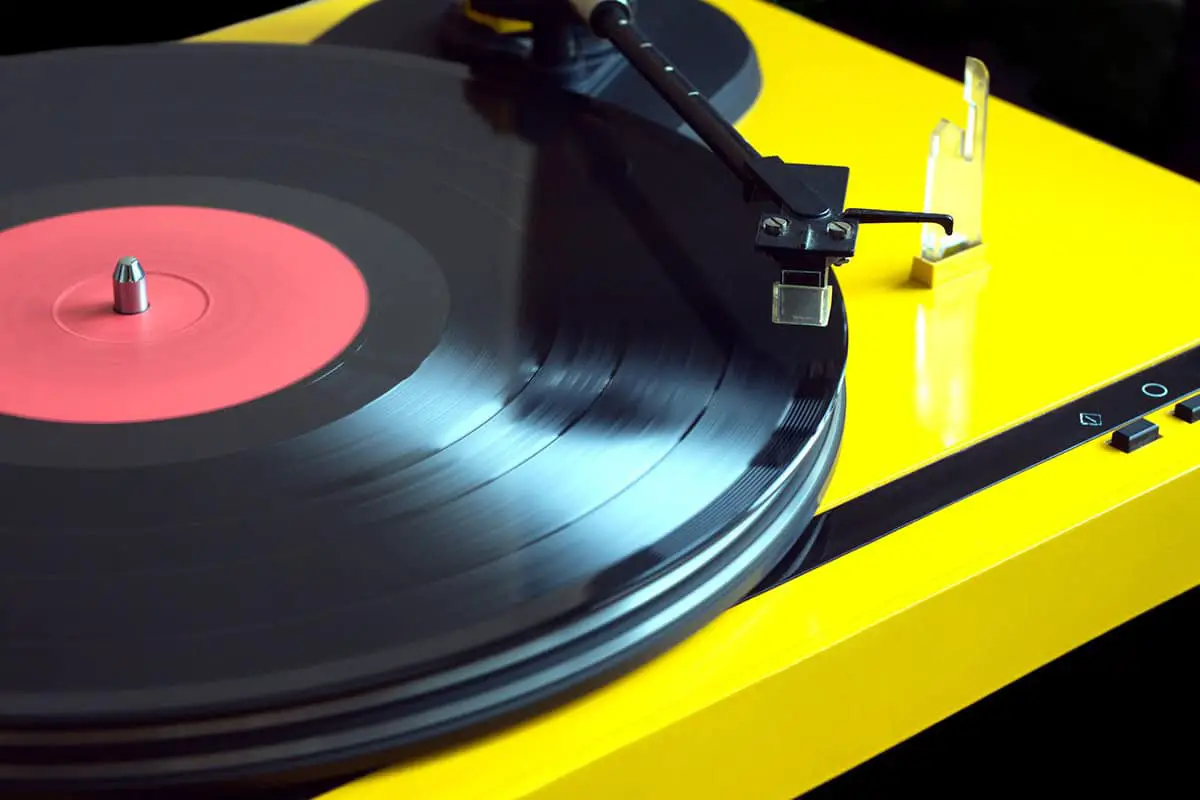This post contains affiliate links.

Does the fact that your turntable is revolving too fast keep you up every night? If it does, you’re an audiophile, and you appreciate the music art. Therefore, you love the idea of listening to live music, and digital music just can’t cut it for you. Plus, you may have a perfect pitch and can tell when the turntable is playing too fast. So to help you solve this issue, we have prepared the following guide to fix a record player that plays too fast.
The vinyl records come in three speeds: 78 rpm, 45 rpm, and 33 1/3 per minute (generally referred to as a 33). The RPM shows how fast your record player should be spinning; therefore, you will know when the speed changes. (source)
Generally, one determines the speed of the record player by the vinyl record; after all, they are designed to spin at a certain pace when playing. You have come to the right place if you notice that your record player is moving too fast. So in this article, we will show you how to fix a record player that is playing too fast. We’ll also show you why your record player is playing too fast.
Table of Contents
Is the Record Player Playing Too Fast?
You should first pick the right spinning speed when you purchase the record player. And if it is not spinning at the right pace, then a technician at the store will help you calibrate it. After all, if calibrated correctly, it can play different vinyl records.
Remember, if the record player is spinning too slowly, it will sound like the battery is low. If the record player is spinning too fast, the music will sound like Alvin-and-the-Chipmunks. (source) And as an audiophile, this can be very frustrating. Therefore, you will know when the speed of the turntable changes.
Generally, only three turntable speeds can play all the vinyl records in the market. For 12-inch vinyl, you will require a rate of about 33 RPM. On the other hand, a 7-inch disc requires a 45 RPM, while the older 10-inch discs play at 78 RMP. So it’s crucial you set the record’s speed correctly. But at times, the record can start spinning faster than usual. (source)
Unfortunately, once you start believing that your record player is playing too fast, your subconscious will convince you that you’re right, and you’ll begin hearing more evidence. So before jumping to a conclusion, it’s always a good idea to first determine if it’s spinning at the right speed. But most folks don’t know how to test the speed of their record player. In fact, most record player owners have never heard of a device for setting the pace of their player.
How Can I Determine the Speed of My Record Player?
To test the speed of the turntable, you need a stroboscopic system. This system features a cardboard disc with equally spaced marks that goes on the record player. In fact, some record players have stroboscopic markings on their edges. This process works thanks to the optical illusion that can help you make precise and fast adjustments when the speed increases. (source)
If you reside in Australia, Asia, or Europe, you will require a 50 Hz disc, and in North America, you will need a disc marked 60 Hz. Fortunately, you can download these discs from the internet or purchase the disc from the local stores. If the record player is spinning at the right speed, the markings may seem to stand still. If the turntable appears to rotate to the right or left, then the spinning rate is off, So you have to adjust it.
The slower or faster the drift, the bigger the error; this illusion is more visible under most lights, including fluorescents. However, some folks prefer LED bulbs or specialized strobe lights. Press the play button, place the strobe disc, and lower the tone-arm for better results. Lowering the tone-arm and pressing play will let you compensate for the extra drag that the stylus and record will impose. (source)
Some unique apps can also help you determine the turntable’s speed, such as the RPM iOS. The RPM (iOS) uses the phone’s gyroscope to measure the turntable’s speed. (source) All you have to do is start the program and place your smartphone on the platter, and press play. The program will measure the speed of the turntable.
How Can You Fix a Record Player That Is Spinning Too Fast?

Even though you set the speed correctly when you purchased the turntable, some record player parts will start wearing out with time. And this will force some features of the record player to either spin faster or slower, thereby distorting the quality of your music. But before you start looking for solutions for this issue, you need to find out the cause of the problem. Plus, this will help you troubleshoot and eventually repair your record player:
Lube, Clean, and Check Every Part of the Turntable
The first thing you should do is ensure that every movable part of the turntable is lubricated and clean. After all, the accumulation of dirt and dust can leave some turntable parts dry and clogged. So before you even test anything else, you should first ensure that the device is well maintained.
Remember, lots of gears and motors in the turntable help your device function better. And for these parts to work, they have to be lubricated, and if there is too much friction, then the turntable’s speed can change. Too much friction can strain some parts of the turntable leaving the others to move even faster than expected.
Another reason the turntable can move faster is the presence of grime and dirt on some of the most crucial parts of the turntable. Dirt or grime on different parts of the turntable can affect the turntable’s speed. So before you even check the other details for wear and tear, you can lube and clean all the movable parts of the turntable.
After all, you must make sure everything is working flawlessly before tweaking the machine. So the first thing you should do is uninstall the platter and look at the motor’s tip. If you notice any grime or dirt, you should scrape it off before cleaning it using a few drops of synthetic oil like the Redline D4-ATF.
Remember, the spindle and the motor’s shaft enter the housing, so you should only use two drops of the Redline D4-ATF. If purchasing a quart of high-tech, cool, exotic transmission lubricant is too much, you should go for the 20-weight oil with PTFE. Before reinstalling the platter, you should also examine the belt. The belt can get misplaced or stretched if it is rubbing on anything.
On the other side, if particles of the turntable belt wear out, they can gunk on the motor pulley resulting in the record player spinning faster. And that is because of the increase in diameter of the motor pulley. So when this happens, you should remove the belt and then clean the pulley using a Q-tip cotton swab dipped in alcohol. But make sure you don’t use rubbing alcohol as it contains lanolin that will force the belt to slip. (source)
After cleaning and lubricating some of the most crucial parts of the turntable, you should reassemble the device and test it. If the speed of the record player is still high, you should proceed to the next step.
Confirm if There Are Any Turntable Belt Problems
The turntable belt resembles all the other straps you may have seen in other devices, including vacuum cleaners. Therefore, it is bound to get repositioned or stretch with time resulting in the speed of the turntable changing. When stretched, even a few millimeters, it can slow down. Even as little as an increase by 6mm can distort your music. (source)
The turntable’s speed can change when one repositions the belt, and its spinning rate increases or decreases accordingly. If it stays in the wrong position for too long, it can become overstretched. If it is repositioned, it can tighten, resulting in the speed of the record player increasing. The best solution is to replace the belt, but you could shrink it back to the average size if it’s still in exceptional condition.
If the turntable belt ends up stretching because of being repositioned, then you should either shrink it down or replace it. To replace the belt, you should do the following:
How to Replace a Damaged Turntable Belt
When dealing with any repair work, the first thing you should do is disconnect it from the power. Unplugging the turntable will help prevent electrical shocks and keep the motor safe. Next, remove the plastic mat that supports the record when playing. Removing the plastic mat is relatively easy; all you have to do is pull it off and place it in a safe place.
Remove the platter situated below the plastic mat, which has two access holes that make it possible for you to monitor the motor. Turn it upside down and place it on a flat surface and then stretch the new belt over the platter’s center hub. Make sure the belt is straight, and if there is a ribbon on it, you can align it with the access holes. It makes it easy for you to install the belt over the motor.
If the platter has no access holes, then you should place a peg on the platter’s edge with the belt already installed on the center circle. Stretch it over the peg and create a round-bottomed triangle. You should ignore this step if the platter has two access holes.
Reinstall the platter making sure the access holes expose its motor; you can use the access holes to access the motor and then stretch it around the body of the motor. If it doesn’t have access holes, you should align the peg or post with the motor spindle. Finally, you can spin the platter clockwise and then anticlockwise to hook the belt on the motor. (source)
After replacing the turntable belt, you can proceed and measure its spinning speed and confirm if it’s back to normal. If the problem persists, you should try switching the spinning speed using the speed selector switch. If it doesn’t work, you should proceed to the next step.
A Speed Selector Switch Issue

All the turntables made after 1960 come with a 2-speed speed-selector switch for 33 1/3 and 45 RPM. (source) Unfortunately, the speed selector can get damaged or be covered with dust, resulting in the speed of the turntable increasing. Accumulation of the grime or the dirt in this switch can force too much voltage on the turntable’s motor, forcing it to spin faster.
If the platter spins slower or faster when you switch the spinning speed, the issue could be the switch. So you can either clean it or replace it once and for all. Cleaning it can work but only for a short period. On the other hand, replacing it can seem costly, but it will save a lot of cash in the end. After confirming that every component is functioning perfectly, the issue may be with calibration.
Rotation Speed Calibration Problems
The calibration issue is the most straightforward solution, especially if you already know how to set the turntable’s speed. Generally, the turntable comes already calibrated when new and functions correctly. But with time, the motor’s speed can change abruptly and need to be calibrated. But before you conclude that it is a calibration problem, you should troubleshoot the above issues.
If the problem persists even after cleaning and lubricating the dry parts of the turntable, then the issue may be with calibration. If the turntable’s speed is still high, you should try calibrating your turntable. Fortunately, most turntables come with manuals that you can find online. Plus, most manuals will show you exactly where the adjustment screws are situated.
If you are using a vintage turntable and can’t find the manual, you can look for a similar model. If you still can’t find the adjustment screws, then you should lift the pad and confirm if the adjustment screw is below the platter. If the adjustment screws are not below the platter, you should look below the motor.
Some turntables have surface holes or knobs that make it easy for you to adjust the turntable from the surface. You can change other turntables from beneath. But you must level your record player before you make any adjustments. Place it on a piece of wood or between two tables to access the underneath parts of the turntable.
The adjustment screws are a set positioned next to each other. The screw that turns clockwise increases the turntable’s speed while the other one lowers the rate. So make sure you set the 33 1/3 RPM first. Some audiophiles use a small screwdriver to adjust, but that is not mandatory. the screws can help change the velocity of the potentiometers, so you should be patient and measure the speed using the app. (source)
Remember, it can be almost impossible to set the right speed, and you might never get to the point in some cases. After all, even if you are 3% off, you will still notice the lag or speed of the turntable is still high. So you have to be very careful and take your time to get within 1% of accuracy.
FAQs
Why Are My Vinyl Records Playing Fast?
The issue is usually a belt that has been improperly installed. If your turntable’s belt slips out of its grooves when the record is playing, it will start riding up and down. The movement of the belt up and down the spindle will force the platter to start spinning fast. Therefore, you will have to reinstall the belt in the platter’s inner ring.
How Can I Fix a Record Player That Is Spinning Too Fast?
The best method for repairing a turntable that spins too fast is recalibrating it. Some screws below the splatter can help you set the right spinning speed. If you don’t know where the calibrating screws are, consult the manual.
Can Dirt Accumulation Increase the Speed of the Turntable?
If not well maintained, most turntable’s movable parts can dry, resulting in increased friction. High friction can strain some parts of the turntable, leaving others to spin very fast.
Conclusion
If not well maintained, the turntable’s speed can increase, resulting in it producing distorted sound. When new, turntables are typically well-calibrated, but the spinning rate can improve with time. Luckily, there is a solution for this problem, and if every other component is working perfectly, then the only solution is recalibrating it.
Sources
- Rich Tozzoli, Here’s What You Need to Know About Vinyl, Accessed December 24, 2021
- Libby Plummer, How toSet Up and Maintain Your Turntable for Analogue Audio Joy, Accessed December 24, 2021
- Nelson Kline, Dialing in Your Turntable Speed, Accessed December 24, 2021
- Wikihow Contributor, How to Replace a Record Player Belt, https://www.wikihow.com/Replace-a-Record-Player-Belt/ Accessed December 24, 2021
- Sam Sauls, Audio Production Worktext: Concepts, Techniques, and Equipment, Accessed December 24, 2021
- NewYork Times staff, How to Set Up Turntable, Accessed December 24, 2021
VacationVinyl.com is a participant in the Amazon Services LLC Associates Program, an affiliate advertising program designed to provide a means for sites to earn advertising fees by advertising and linking to Amazon.com. We also participate in other affiliate programs which compensate us for referring traffic.






